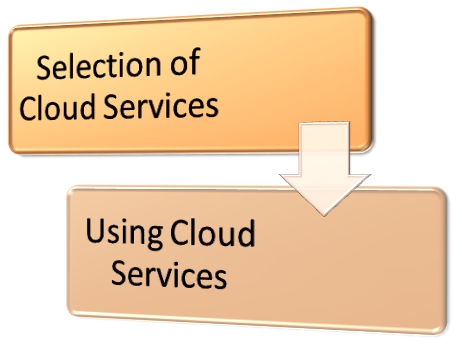
- |
- |
There are broadly speaking two key stages for cloud service adoption, namely “selection of cloud services” and “usage of cloud services”.

Stage 1 : Selection of Cloud Services
Cloud computing can possibly provide different business values. In general, such benefits can be grouped under three categories as follows:
- Operational Savings – improvements in computer resource utilisation, lowered labour costs and power consumption, etc.
- Agility – flexibility for handling business changes, reduced lead time for providing new services, etc.
- Innovation –taking advantage of the cloud service provider's innovative provisions without owning or managing the related complex IT assets.
The following table lists some major types of cloud services commonly available in the market.
| Types of Services | Specific Benefits |
|---|---|
| Productivity applications (e.g. word processing, spreadsheet, e-mail and unified communication, etc.) |
Work anywhere, anytime and using any device |
| Business Application (e.g. CRM, ERP, HR, development, testing and hosting, etc.) |
Fast and flexible deployment Agility to adapt for fluctuation on computing demand |
| Social Networking (e.g. photo and video sharing etc.) |
Direct communication with customers, especially those of younger ages |
| Cloud IT Service (e.g. backup and storage, etc.) |
Off-site storage provides additional resilience Access documents and files anywhere using any device |
To determine the readiness of adoption, the following are some of the major activities involved:
- Identify the requirements for the existing applications to be migrated to the cloud environment.
- Search the market for likely source of cloud service providers that can meet the requirements with a cost-effective pricing model.
- Look out for other infrastructural (e.g. networking) or procedural (e.g. auditing) changes required to enable the adoption.
Stage 2 : Using Cloud Services
After confirming the business needs and readiness for adopting a cloud service, companies can start their implementation and usage of the service. This would typically involve:
- Contractual arrangements with the cloud service provider with mutually agreed service level agreements (SLA)
- Application and / or data migration of existing systems
- System testing and acceptance
- Production system launch
- User training and support
- On-going management and monitoring of the service performance
The Government of the Hong Kong Special Administrative Region of the People's Republic of China







 Share
Share 









